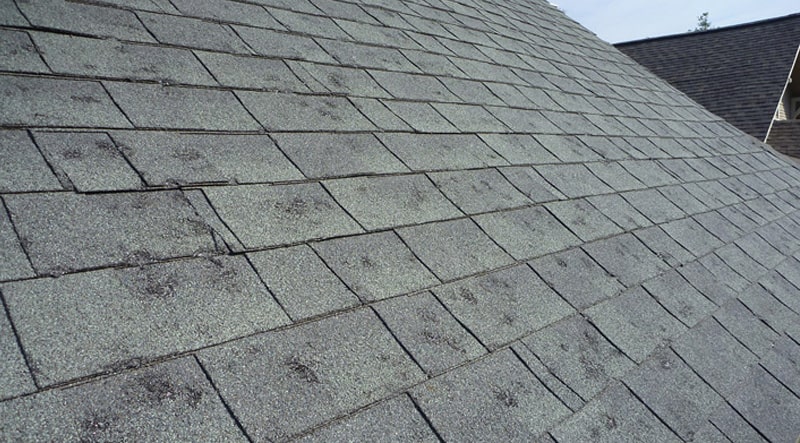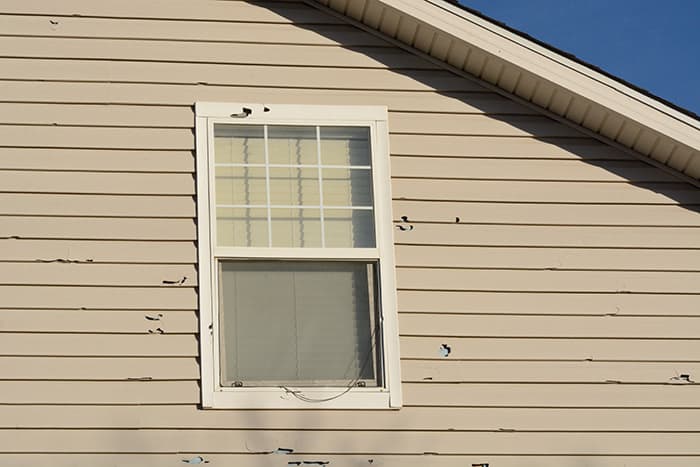Hailstorms are widespread in Colorado, and they frequently cause roof hail damage to homeowners and businesses. Continue reading to discover how to spot roof damage after a hailstorm.
Key Signs of Roof Hail Damage

Damaged Shingles
Hail may be extremely damaging to shingles. Hailstones may be exceedingly damaging to your shingles, whether they are composed of asphalt, clay, slate, or any other roofing material.
After a hailstorm, your shingles may be broken, pierced, or gone entirely. After the storm, look around the perimeter of your property for shingle debris or shingles that have totally broken off your roof.
Asphalt Shingle Damage
After a hailstorm, you may see bruising or missing asphalt granules if you have asphalt shingles. When hailstones strike asphalt shingles, an indentation appears where the hailstone struck the shingle’s surface. In a hailstorm, the protective layer of asphalt shingles may also erode. Small asphalt particles may collect around your property or in your gutter system in this situation.
Even if your roof’s asphalt shingles are only damaged or missing granules, you should contact local Denver roofing professionals for repairs. In this situation, the shingle’s durability has been weakened, leaving the entire roofing system more vulnerable to catastrophic damage, such as a leak.Repairing the damaged shingles sooner rather than later will keep the repair costs to a minimum and save you a great deal of stress.
Slate Tile Damage
After a hailstorm in Denver, slate tiles might be severely damaged. While slate tiles are recognized for their durability, hailstones that strike the surface of your roof with a lot of power can puncture the slate tiles all the way through. Hailstone-caused holes in slate tiles have crisp edges, making roof hail damage easier to distinguish from other forms of roof damage. To minimize future issues, get hail damage to a slate roof repaired as soon as possible, just like you would with asphalt roofing.
Window Damage
During a hailstorm, the exterior of your home’s windows might be damaged. While window damage has no bearing on your roofing system, assessing the damage after a hailstorm is an easy approach to determine whether roof hail damage is possible.
After a hailstorm, your windowsills, window casings, and window glass may be damaged. Hailstones may impact these components of your home, reducing its beauty and longevity.
Hailstones can damage or shatter your window panes in heavy hailstorms. After a storm, you could find cracked window seals. It’s critical to arrange repairs as soon as possible, especially for major forms of window damage, to keep your house safe from water damage and other outside hazards. Additionally, if you see hail damage to your windows, you should arrange a roof check. If your windows were harmed by the hailstorm, it’s likely that your roofing system was also harmed.
Gutter Damage
Gutter damage, like window damage, might indicate that your roof requires maintenance following a hailstorm in Denver. After major hailstorms, dents in gutters, downspouts, and/or gutter screens are typical. Hailstones large enough to ding your gutter system will likewise ding your roof.
Your gutter system may suffer a leak after a severe hailstorm. This usually happens when your gutters have been punctured by hail. Water damage to the exterior of your home, as well as the foundation, can be caused by leaking gutters. So, don’t leave a hail-damaged gutter or roofing system alone; get roof repair professionals to inspect it.

Insurance For Roof Hail Damage
Almost all homeowner’s insurance policies cover roof hail damage. Hailstorms are covered by most homeowner’s insurance plans since they are uncontrollable. If your roofing system has been damaged by a hailstorm, you should make a claim with your insurance company to get compensation. At Canopy Roof and Restoration, we can assist you with filing an insurance claim so that you may get reimbursement for roof hail damage repairs as soon as possible. To begin the process of making a claim following a hailstorm, contact us as soon as possible. The sooner you file your claim, the more likely it is to be approved.





